ACCT20073: Medibank's Compliance with Accounting Standards 2018
VerifiedAdded on 2023/04/20
|10
|2533
|172
Report
AI Summary
This report provides an analysis of Simba Limited’s adoption of the fair value method and Medibank’s 2018 annual report, evaluating its compliance with AASB 13/ IFRS 13, AASB 116/IAS 16, and AASB 136/ IAS 39. The report justifies Simba Limited’s decision to use the fair value method for better financial statement presentation and discusses its computation based on income, cost, and market approaches. It also highlights the importance of impairment testing to prevent asset overvaluation and details Medibank’s asset measurement, valuation techniques, and impairment testing procedures, including goodwill assessment and disclosures in the notes to the accounts. The analysis reveals Medibank's adherence to accounting standards in measuring and disclosing impairment losses, particularly for goodwill and intangible assets, ensuring that assets are not overstated and that necessary provisions are made for potential changes in circumstances. Desklib provides a platform to access this document and many more solved assignments.
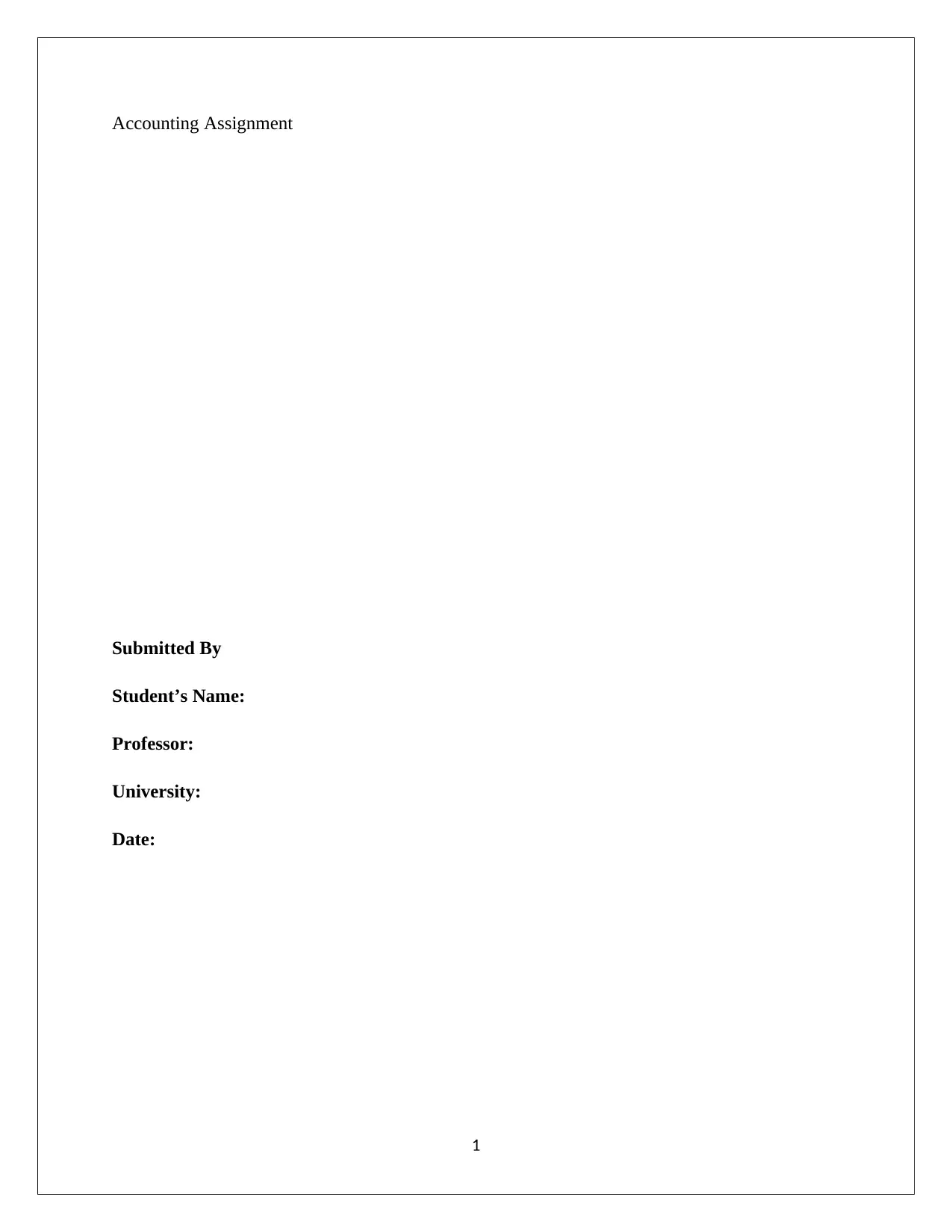
Accounting Assignment
Submitted By
Student’s Name:
Professor:
University:
Date:
1
Submitted By
Student’s Name:
Professor:
University:
Date:
1
Paraphrase This Document
Need a fresh take? Get an instant paraphrase of this document with our AI Paraphraser
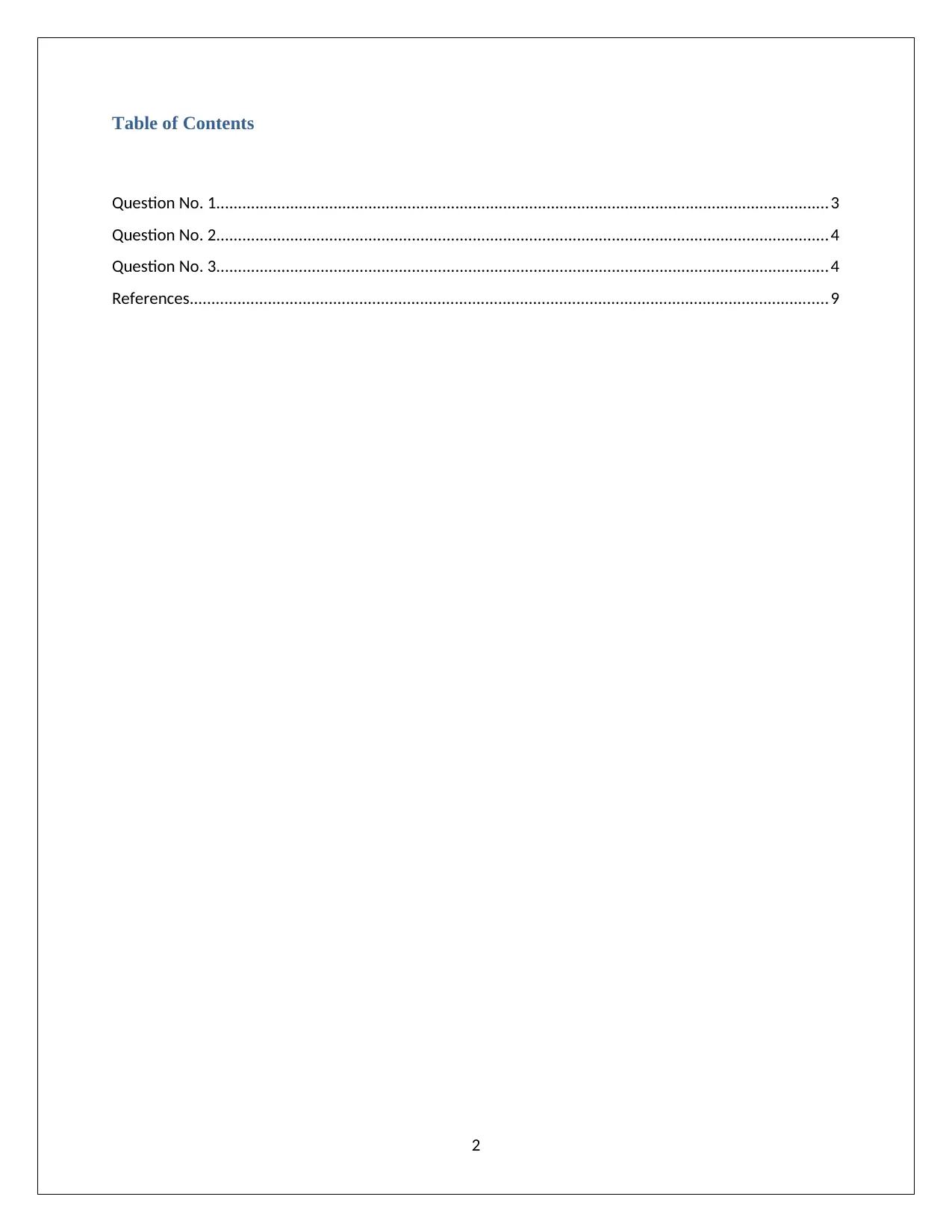
Table of Contents
Question No. 1.............................................................................................................................................3
Question No. 2.............................................................................................................................................4
Question No. 3.............................................................................................................................................4
References...................................................................................................................................................9
2
Question No. 1.............................................................................................................................................3
Question No. 2.............................................................................................................................................4
Question No. 3.............................................................................................................................................4
References...................................................................................................................................................9
2
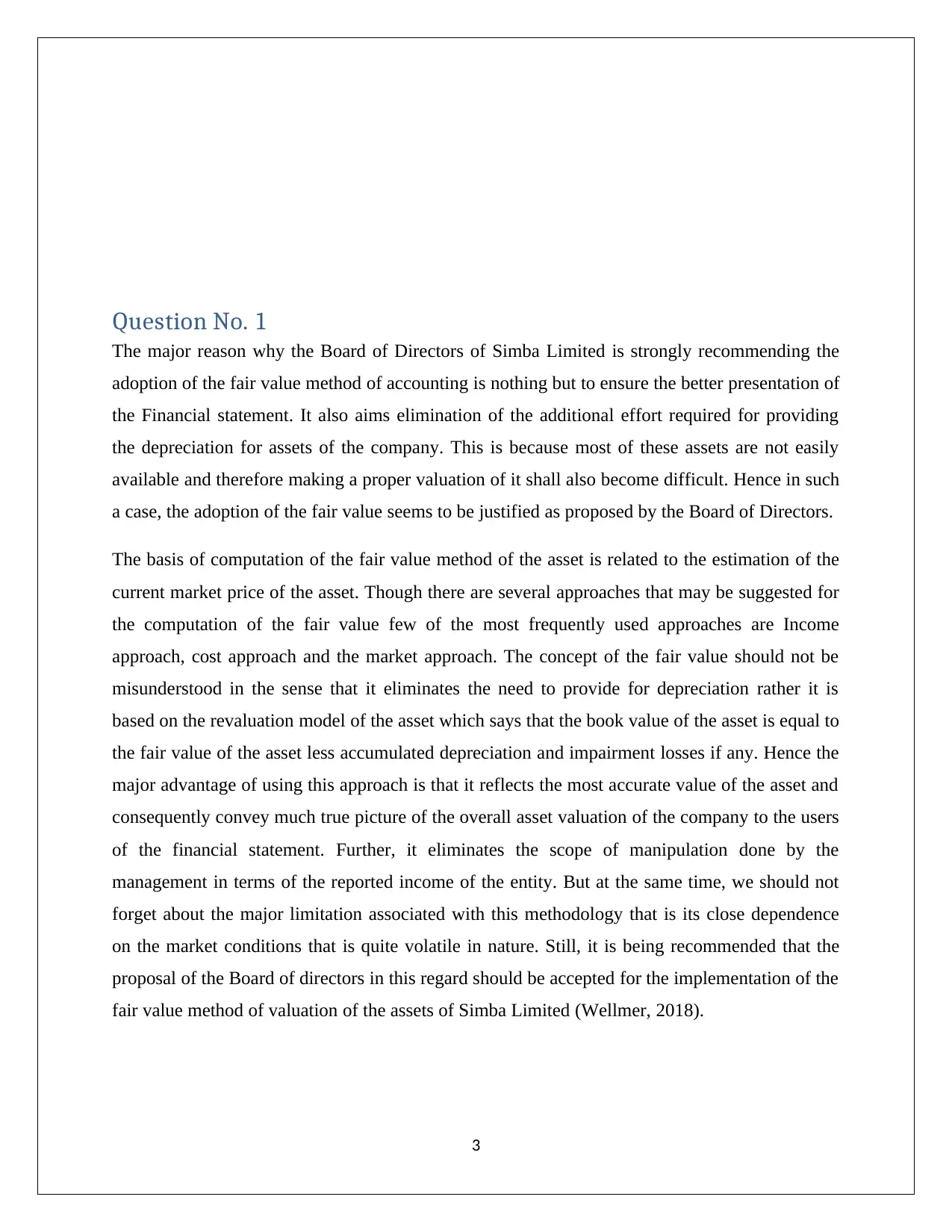
Question No. 1
The major reason why the Board of Directors of Simba Limited is strongly recommending the
adoption of the fair value method of accounting is nothing but to ensure the better presentation of
the Financial statement. It also aims elimination of the additional effort required for providing
the depreciation for assets of the company. This is because most of these assets are not easily
available and therefore making a proper valuation of it shall also become difficult. Hence in such
a case, the adoption of the fair value seems to be justified as proposed by the Board of Directors.
The basis of computation of the fair value method of the asset is related to the estimation of the
current market price of the asset. Though there are several approaches that may be suggested for
the computation of the fair value few of the most frequently used approaches are Income
approach, cost approach and the market approach. The concept of the fair value should not be
misunderstood in the sense that it eliminates the need to provide for depreciation rather it is
based on the revaluation model of the asset which says that the book value of the asset is equal to
the fair value of the asset less accumulated depreciation and impairment losses if any. Hence the
major advantage of using this approach is that it reflects the most accurate value of the asset and
consequently convey much true picture of the overall asset valuation of the company to the users
of the financial statement. Further, it eliminates the scope of manipulation done by the
management in terms of the reported income of the entity. But at the same time, we should not
forget about the major limitation associated with this methodology that is its close dependence
on the market conditions that is quite volatile in nature. Still, it is being recommended that the
proposal of the Board of directors in this regard should be accepted for the implementation of the
fair value method of valuation of the assets of Simba Limited (Wellmer, 2018).
3
The major reason why the Board of Directors of Simba Limited is strongly recommending the
adoption of the fair value method of accounting is nothing but to ensure the better presentation of
the Financial statement. It also aims elimination of the additional effort required for providing
the depreciation for assets of the company. This is because most of these assets are not easily
available and therefore making a proper valuation of it shall also become difficult. Hence in such
a case, the adoption of the fair value seems to be justified as proposed by the Board of Directors.
The basis of computation of the fair value method of the asset is related to the estimation of the
current market price of the asset. Though there are several approaches that may be suggested for
the computation of the fair value few of the most frequently used approaches are Income
approach, cost approach and the market approach. The concept of the fair value should not be
misunderstood in the sense that it eliminates the need to provide for depreciation rather it is
based on the revaluation model of the asset which says that the book value of the asset is equal to
the fair value of the asset less accumulated depreciation and impairment losses if any. Hence the
major advantage of using this approach is that it reflects the most accurate value of the asset and
consequently convey much true picture of the overall asset valuation of the company to the users
of the financial statement. Further, it eliminates the scope of manipulation done by the
management in terms of the reported income of the entity. But at the same time, we should not
forget about the major limitation associated with this methodology that is its close dependence
on the market conditions that is quite volatile in nature. Still, it is being recommended that the
proposal of the Board of directors in this regard should be accepted for the implementation of the
fair value method of valuation of the assets of Simba Limited (Wellmer, 2018).
3
⊘ This is a preview!⊘
Do you want full access?
Subscribe today to unlock all pages.

Trusted by 1+ million students worldwide
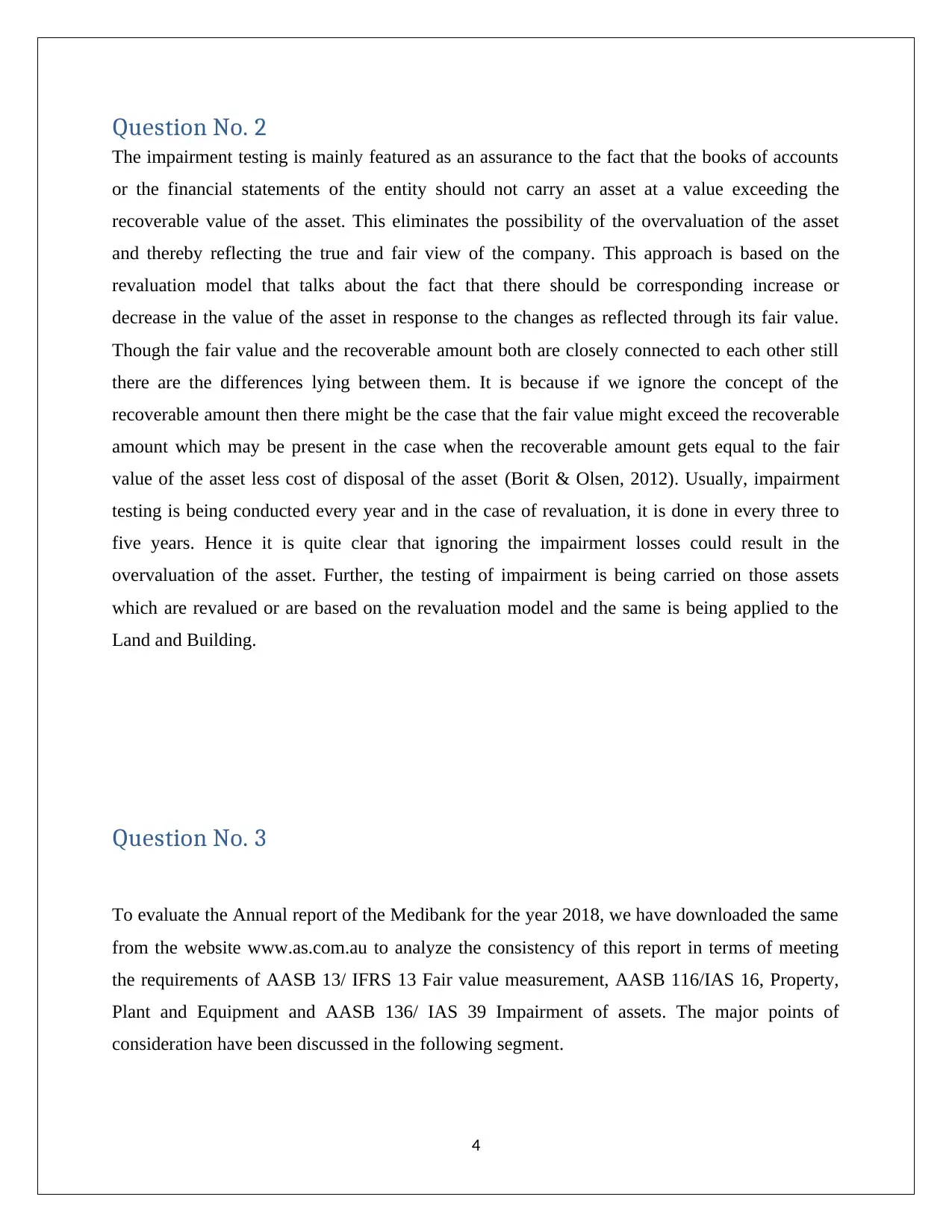
Question No. 2
The impairment testing is mainly featured as an assurance to the fact that the books of accounts
or the financial statements of the entity should not carry an asset at a value exceeding the
recoverable value of the asset. This eliminates the possibility of the overvaluation of the asset
and thereby reflecting the true and fair view of the company. This approach is based on the
revaluation model that talks about the fact that there should be corresponding increase or
decrease in the value of the asset in response to the changes as reflected through its fair value.
Though the fair value and the recoverable amount both are closely connected to each other still
there are the differences lying between them. It is because if we ignore the concept of the
recoverable amount then there might be the case that the fair value might exceed the recoverable
amount which may be present in the case when the recoverable amount gets equal to the fair
value of the asset less cost of disposal of the asset (Borit & Olsen, 2012). Usually, impairment
testing is being conducted every year and in the case of revaluation, it is done in every three to
five years. Hence it is quite clear that ignoring the impairment losses could result in the
overvaluation of the asset. Further, the testing of impairment is being carried on those assets
which are revalued or are based on the revaluation model and the same is being applied to the
Land and Building.
Question No. 3
To evaluate the Annual report of the Medibank for the year 2018, we have downloaded the same
from the website www.as.com.au to analyze the consistency of this report in terms of meeting
the requirements of AASB 13/ IFRS 13 Fair value measurement, AASB 116/IAS 16, Property,
Plant and Equipment and AASB 136/ IAS 39 Impairment of assets. The major points of
consideration have been discussed in the following segment.
4
The impairment testing is mainly featured as an assurance to the fact that the books of accounts
or the financial statements of the entity should not carry an asset at a value exceeding the
recoverable value of the asset. This eliminates the possibility of the overvaluation of the asset
and thereby reflecting the true and fair view of the company. This approach is based on the
revaluation model that talks about the fact that there should be corresponding increase or
decrease in the value of the asset in response to the changes as reflected through its fair value.
Though the fair value and the recoverable amount both are closely connected to each other still
there are the differences lying between them. It is because if we ignore the concept of the
recoverable amount then there might be the case that the fair value might exceed the recoverable
amount which may be present in the case when the recoverable amount gets equal to the fair
value of the asset less cost of disposal of the asset (Borit & Olsen, 2012). Usually, impairment
testing is being conducted every year and in the case of revaluation, it is done in every three to
five years. Hence it is quite clear that ignoring the impairment losses could result in the
overvaluation of the asset. Further, the testing of impairment is being carried on those assets
which are revalued or are based on the revaluation model and the same is being applied to the
Land and Building.
Question No. 3
To evaluate the Annual report of the Medibank for the year 2018, we have downloaded the same
from the website www.as.com.au to analyze the consistency of this report in terms of meeting
the requirements of AASB 13/ IFRS 13 Fair value measurement, AASB 116/IAS 16, Property,
Plant and Equipment and AASB 136/ IAS 39 Impairment of assets. The major points of
consideration have been discussed in the following segment.
4
Paraphrase This Document
Need a fresh take? Get an instant paraphrase of this document with our AI Paraphraser

a. From the Annual report of the Medibank for the year ending 2018, it is clearly observed that
all the assets of the bank have been measured at the historical cost other than those of the
financial assets (Webster, 2017). The major financial assets of the Bank include the internally
managed fixed income portfolio, externally managed direct mandates and the equity trusts. The
fair value method of valuation has been used while valuing the Land and Building. Different
techniques like making conventions based on overall market conditions, dealer quotation for
similar instruments, quoted market prices and several other techniques have been used for the
fair value measurement of the investments. The fair value of the liabilities has been expressed in
terms of the present value of the expected future payments.
b. The notes to the accounts, as appended to the statement of the Financial position and
statement of income together with the cash flow statement, shows the management disclosure in
relation to the type of the valuation techniques used along with the basis for measurement of
valuation for most of the assets (Vieira, O’Dwyer, & Schneider, 2017).
For example, while making the calculation of the fair value of the investment it seems that
several techniques like quoted market prices, dealer’s quotation for the similar instruments, yield
curve calculation based on mid yield have been used. In the same way, the independent together
with the vendor developed methods too have been used in this regard.
Similarly, for the private health insurance schemes the use of the fair value has been made for the
recognition of the revenue in the form of premium and the straight-line basis between the dates
of accepting the overall risk and the actual date of making the payment of premium has been
used as a basis of recognition of the overall consideration.
The concept of the fair value method of accounting is itself subjective in nature and this is the
reason why the categorization of the investment seemed to be dependent on the overall
5
all the assets of the bank have been measured at the historical cost other than those of the
financial assets (Webster, 2017). The major financial assets of the Bank include the internally
managed fixed income portfolio, externally managed direct mandates and the equity trusts. The
fair value method of valuation has been used while valuing the Land and Building. Different
techniques like making conventions based on overall market conditions, dealer quotation for
similar instruments, quoted market prices and several other techniques have been used for the
fair value measurement of the investments. The fair value of the liabilities has been expressed in
terms of the present value of the expected future payments.
b. The notes to the accounts, as appended to the statement of the Financial position and
statement of income together with the cash flow statement, shows the management disclosure in
relation to the type of the valuation techniques used along with the basis for measurement of
valuation for most of the assets (Vieira, O’Dwyer, & Schneider, 2017).
For example, while making the calculation of the fair value of the investment it seems that
several techniques like quoted market prices, dealer’s quotation for the similar instruments, yield
curve calculation based on mid yield have been used. In the same way, the independent together
with the vendor developed methods too have been used in this regard.
Similarly, for the private health insurance schemes the use of the fair value has been made for the
recognition of the revenue in the form of premium and the straight-line basis between the dates
of accepting the overall risk and the actual date of making the payment of premium has been
used as a basis of recognition of the overall consideration.
The concept of the fair value method of accounting is itself subjective in nature and this is the
reason why the categorization of the investment seemed to be dependent on the overall
5
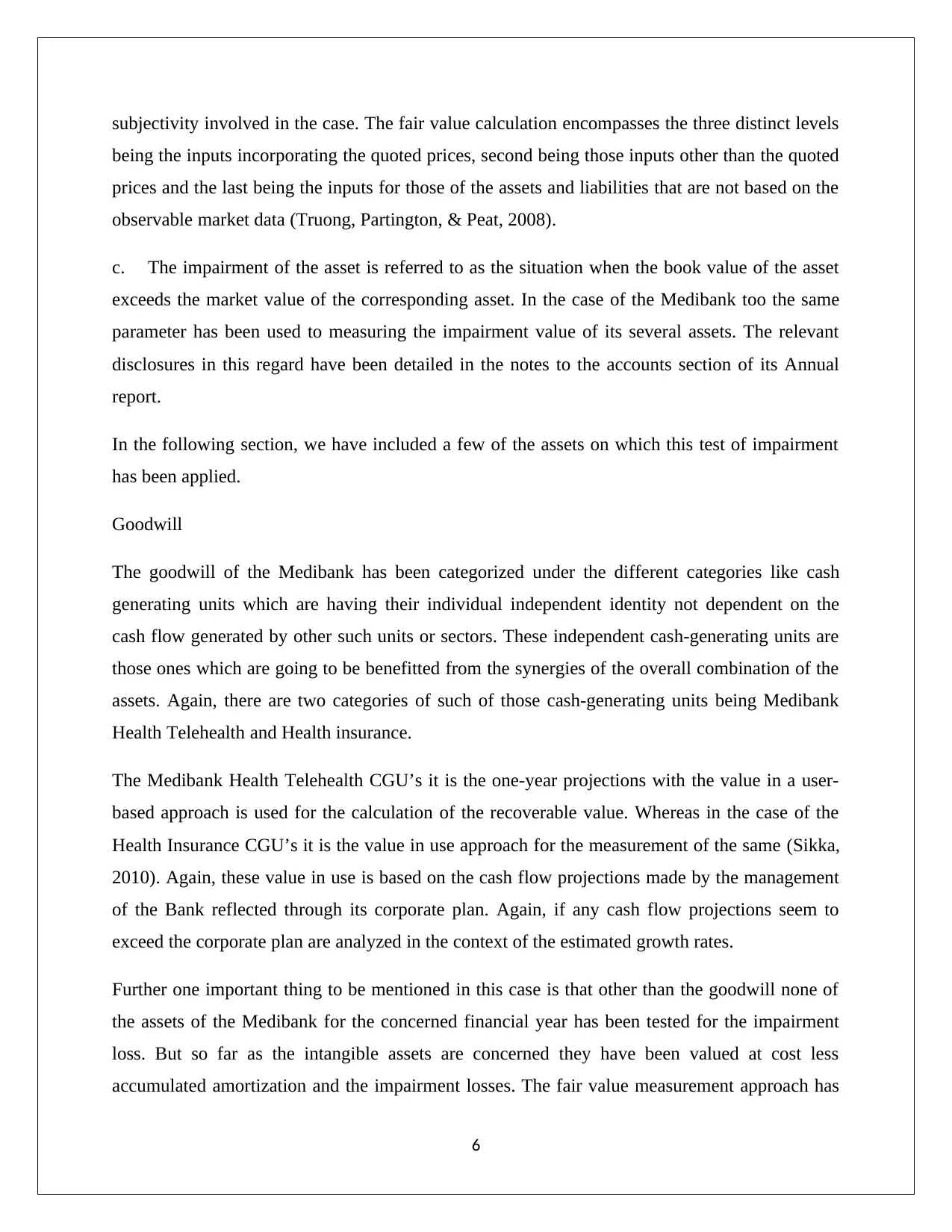
subjectivity involved in the case. The fair value calculation encompasses the three distinct levels
being the inputs incorporating the quoted prices, second being those inputs other than the quoted
prices and the last being the inputs for those of the assets and liabilities that are not based on the
observable market data (Truong, Partington, & Peat, 2008).
c. The impairment of the asset is referred to as the situation when the book value of the asset
exceeds the market value of the corresponding asset. In the case of the Medibank too the same
parameter has been used to measuring the impairment value of its several assets. The relevant
disclosures in this regard have been detailed in the notes to the accounts section of its Annual
report.
In the following section, we have included a few of the assets on which this test of impairment
has been applied.
Goodwill
The goodwill of the Medibank has been categorized under the different categories like cash
generating units which are having their individual independent identity not dependent on the
cash flow generated by other such units or sectors. These independent cash-generating units are
those ones which are going to be benefitted from the synergies of the overall combination of the
assets. Again, there are two categories of such of those cash-generating units being Medibank
Health Telehealth and Health insurance.
The Medibank Health Telehealth CGU’s it is the one-year projections with the value in a user-
based approach is used for the calculation of the recoverable value. Whereas in the case of the
Health Insurance CGU’s it is the value in use approach for the measurement of the same (Sikka,
2010). Again, these value in use is based on the cash flow projections made by the management
of the Bank reflected through its corporate plan. Again, if any cash flow projections seem to
exceed the corporate plan are analyzed in the context of the estimated growth rates.
Further one important thing to be mentioned in this case is that other than the goodwill none of
the assets of the Medibank for the concerned financial year has been tested for the impairment
loss. But so far as the intangible assets are concerned they have been valued at cost less
accumulated amortization and the impairment losses. The fair value measurement approach has
6
being the inputs incorporating the quoted prices, second being those inputs other than the quoted
prices and the last being the inputs for those of the assets and liabilities that are not based on the
observable market data (Truong, Partington, & Peat, 2008).
c. The impairment of the asset is referred to as the situation when the book value of the asset
exceeds the market value of the corresponding asset. In the case of the Medibank too the same
parameter has been used to measuring the impairment value of its several assets. The relevant
disclosures in this regard have been detailed in the notes to the accounts section of its Annual
report.
In the following section, we have included a few of the assets on which this test of impairment
has been applied.
Goodwill
The goodwill of the Medibank has been categorized under the different categories like cash
generating units which are having their individual independent identity not dependent on the
cash flow generated by other such units or sectors. These independent cash-generating units are
those ones which are going to be benefitted from the synergies of the overall combination of the
assets. Again, there are two categories of such of those cash-generating units being Medibank
Health Telehealth and Health insurance.
The Medibank Health Telehealth CGU’s it is the one-year projections with the value in a user-
based approach is used for the calculation of the recoverable value. Whereas in the case of the
Health Insurance CGU’s it is the value in use approach for the measurement of the same (Sikka,
2010). Again, these value in use is based on the cash flow projections made by the management
of the Bank reflected through its corporate plan. Again, if any cash flow projections seem to
exceed the corporate plan are analyzed in the context of the estimated growth rates.
Further one important thing to be mentioned in this case is that other than the goodwill none of
the assets of the Medibank for the concerned financial year has been tested for the impairment
loss. But so far as the intangible assets are concerned they have been valued at cost less
accumulated amortization and the impairment losses. The fair value measurement approach has
6
⊘ This is a preview!⊘
Do you want full access?
Subscribe today to unlock all pages.

Trusted by 1+ million students worldwide
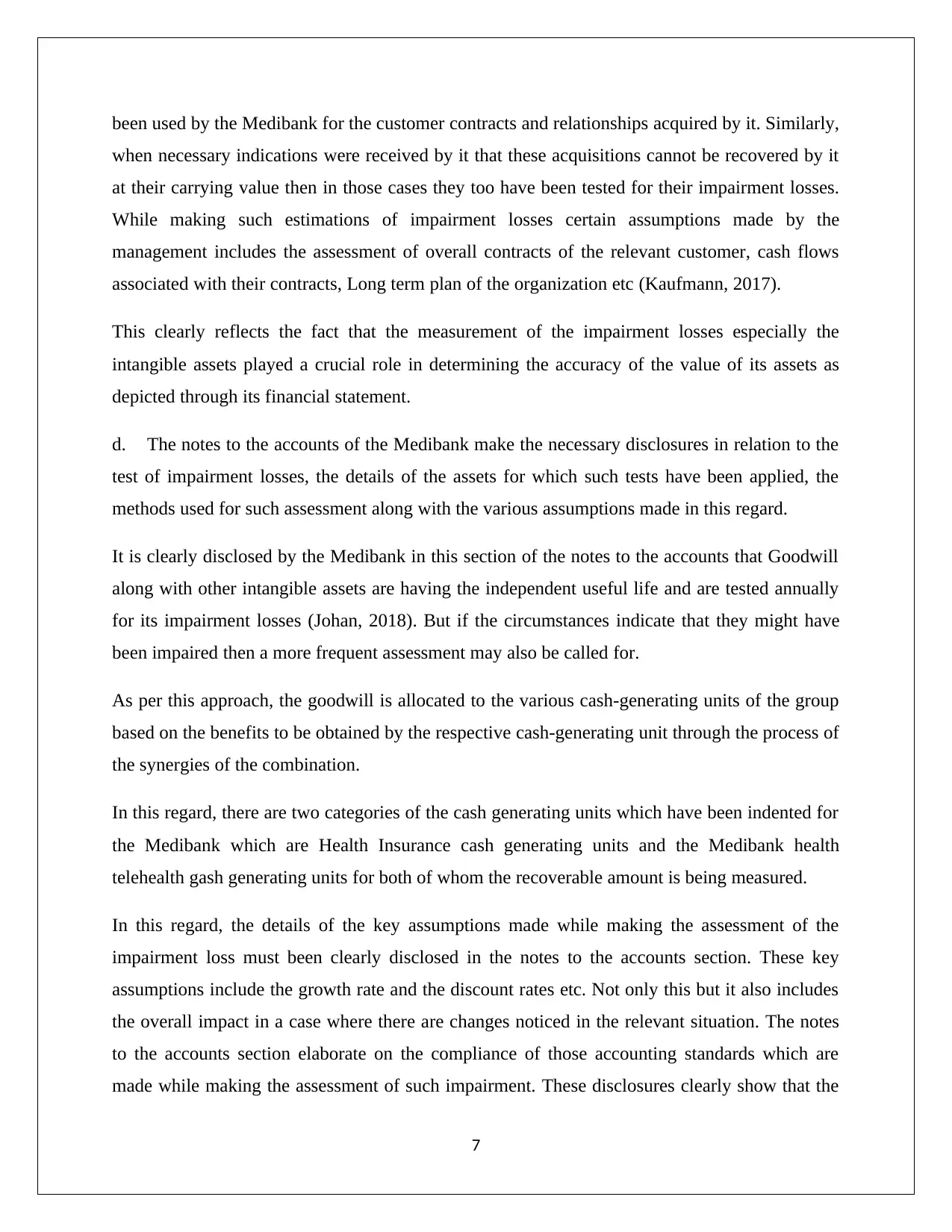
been used by the Medibank for the customer contracts and relationships acquired by it. Similarly,
when necessary indications were received by it that these acquisitions cannot be recovered by it
at their carrying value then in those cases they too have been tested for their impairment losses.
While making such estimations of impairment losses certain assumptions made by the
management includes the assessment of overall contracts of the relevant customer, cash flows
associated with their contracts, Long term plan of the organization etc (Kaufmann, 2017).
This clearly reflects the fact that the measurement of the impairment losses especially the
intangible assets played a crucial role in determining the accuracy of the value of its assets as
depicted through its financial statement.
d. The notes to the accounts of the Medibank make the necessary disclosures in relation to the
test of impairment losses, the details of the assets for which such tests have been applied, the
methods used for such assessment along with the various assumptions made in this regard.
It is clearly disclosed by the Medibank in this section of the notes to the accounts that Goodwill
along with other intangible assets are having the independent useful life and are tested annually
for its impairment losses (Johan, 2018). But if the circumstances indicate that they might have
been impaired then a more frequent assessment may also be called for.
As per this approach, the goodwill is allocated to the various cash-generating units of the group
based on the benefits to be obtained by the respective cash-generating unit through the process of
the synergies of the combination.
In this regard, there are two categories of the cash generating units which have been indented for
the Medibank which are Health Insurance cash generating units and the Medibank health
telehealth gash generating units for both of whom the recoverable amount is being measured.
In this regard, the details of the key assumptions made while making the assessment of the
impairment loss must been clearly disclosed in the notes to the accounts section. These key
assumptions include the growth rate and the discount rates etc. Not only this but it also includes
the overall impact in a case where there are changes noticed in the relevant situation. The notes
to the accounts section elaborate on the compliance of those accounting standards which are
made while making the assessment of such impairment. These disclosures clearly show that the
7
when necessary indications were received by it that these acquisitions cannot be recovered by it
at their carrying value then in those cases they too have been tested for their impairment losses.
While making such estimations of impairment losses certain assumptions made by the
management includes the assessment of overall contracts of the relevant customer, cash flows
associated with their contracts, Long term plan of the organization etc (Kaufmann, 2017).
This clearly reflects the fact that the measurement of the impairment losses especially the
intangible assets played a crucial role in determining the accuracy of the value of its assets as
depicted through its financial statement.
d. The notes to the accounts of the Medibank make the necessary disclosures in relation to the
test of impairment losses, the details of the assets for which such tests have been applied, the
methods used for such assessment along with the various assumptions made in this regard.
It is clearly disclosed by the Medibank in this section of the notes to the accounts that Goodwill
along with other intangible assets are having the independent useful life and are tested annually
for its impairment losses (Johan, 2018). But if the circumstances indicate that they might have
been impaired then a more frequent assessment may also be called for.
As per this approach, the goodwill is allocated to the various cash-generating units of the group
based on the benefits to be obtained by the respective cash-generating unit through the process of
the synergies of the combination.
In this regard, there are two categories of the cash generating units which have been indented for
the Medibank which are Health Insurance cash generating units and the Medibank health
telehealth gash generating units for both of whom the recoverable amount is being measured.
In this regard, the details of the key assumptions made while making the assessment of the
impairment loss must been clearly disclosed in the notes to the accounts section. These key
assumptions include the growth rate and the discount rates etc. Not only this but it also includes
the overall impact in a case where there are changes noticed in the relevant situation. The notes
to the accounts section elaborate on the compliance of those accounting standards which are
made while making the assessment of such impairment. These disclosures clearly show that the
7
Paraphrase This Document
Need a fresh take? Get an instant paraphrase of this document with our AI Paraphraser
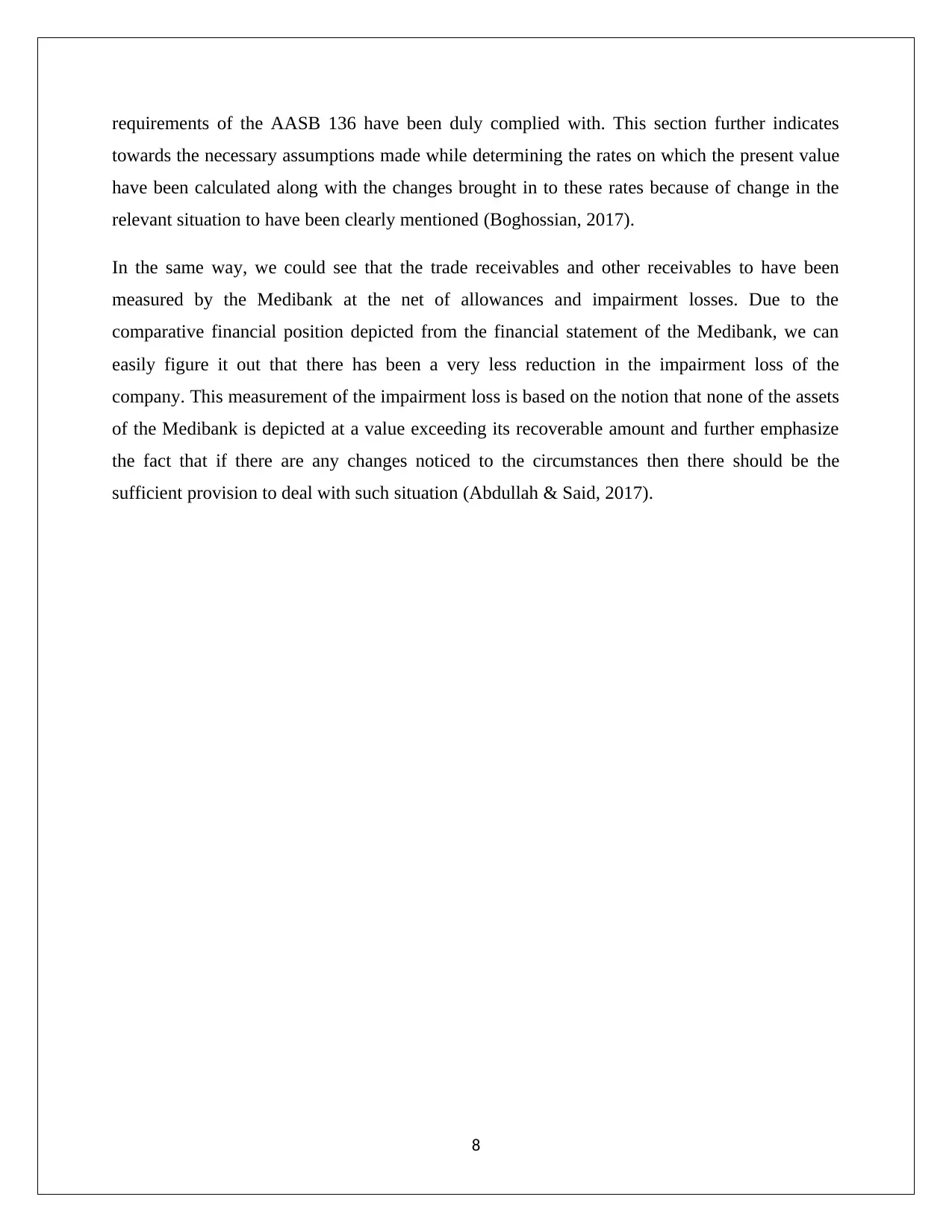
requirements of the AASB 136 have been duly complied with. This section further indicates
towards the necessary assumptions made while determining the rates on which the present value
have been calculated along with the changes brought in to these rates because of change in the
relevant situation to have been clearly mentioned (Boghossian, 2017).
In the same way, we could see that the trade receivables and other receivables to have been
measured by the Medibank at the net of allowances and impairment losses. Due to the
comparative financial position depicted from the financial statement of the Medibank, we can
easily figure it out that there has been a very less reduction in the impairment loss of the
company. This measurement of the impairment loss is based on the notion that none of the assets
of the Medibank is depicted at a value exceeding its recoverable amount and further emphasize
the fact that if there are any changes noticed to the circumstances then there should be the
sufficient provision to deal with such situation (Abdullah & Said, 2017).
8
towards the necessary assumptions made while determining the rates on which the present value
have been calculated along with the changes brought in to these rates because of change in the
relevant situation to have been clearly mentioned (Boghossian, 2017).
In the same way, we could see that the trade receivables and other receivables to have been
measured by the Medibank at the net of allowances and impairment losses. Due to the
comparative financial position depicted from the financial statement of the Medibank, we can
easily figure it out that there has been a very less reduction in the impairment loss of the
company. This measurement of the impairment loss is based on the notion that none of the assets
of the Medibank is depicted at a value exceeding its recoverable amount and further emphasize
the fact that if there are any changes noticed to the circumstances then there should be the
sufficient provision to deal with such situation (Abdullah & Said, 2017).
8
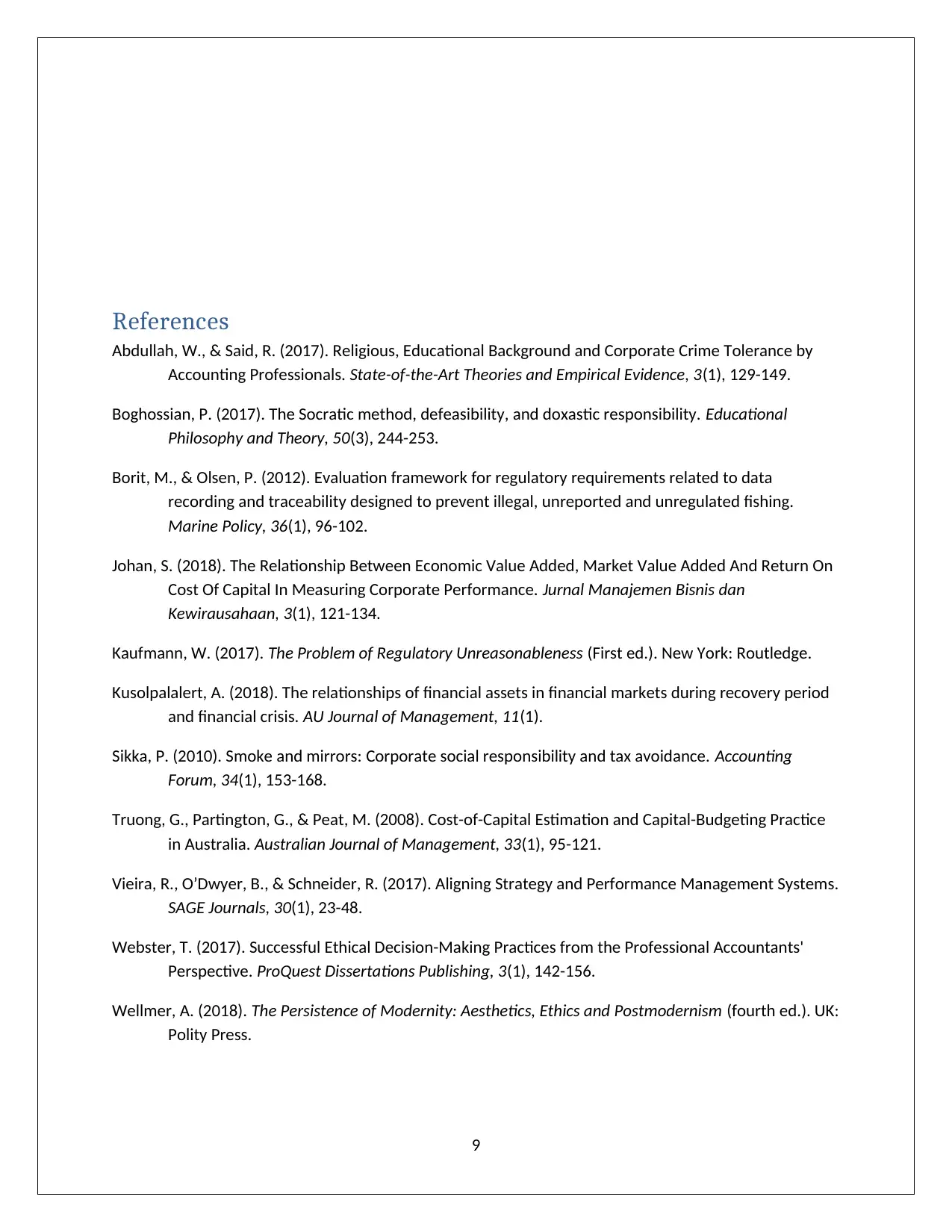
References
Abdullah, W., & Said, R. (2017). Religious, Educational Background and Corporate Crime Tolerance by
Accounting Professionals. State-of-the-Art Theories and Empirical Evidence, 3(1), 129-149.
Boghossian, P. (2017). The Socratic method, defeasibility, and doxastic responsibility. Educational
Philosophy and Theory, 50(3), 244-253.
Borit, M., & Olsen, P. (2012). Evaluation framework for regulatory requirements related to data
recording and traceability designed to prevent illegal, unreported and unregulated fishing.
Marine Policy, 36(1), 96-102.
Johan, S. (2018). The Relationship Between Economic Value Added, Market Value Added And Return On
Cost Of Capital In Measuring Corporate Performance. Jurnal Manajemen Bisnis dan
Kewirausahaan, 3(1), 121-134.
Kaufmann, W. (2017). The Problem of Regulatory Unreasonableness (First ed.). New York: Routledge.
Kusolpalalert, A. (2018). The relationships of financial assets in financial markets during recovery period
and financial crisis. AU Journal of Management, 11(1).
Sikka, P. (2010). Smoke and mirrors: Corporate social responsibility and tax avoidance. Accounting
Forum, 34(1), 153-168.
Truong, G., Partington, G., & Peat, M. (2008). Cost-of-Capital Estimation and Capital-Budgeting Practice
in Australia. Australian Journal of Management, 33(1), 95-121.
Vieira, R., O’Dwyer, B., & Schneider, R. (2017). Aligning Strategy and Performance Management Systems.
SAGE Journals, 30(1), 23-48.
Webster, T. (2017). Successful Ethical Decision-Making Practices from the Professional Accountants'
Perspective. ProQuest Dissertations Publishing, 3(1), 142-156.
Wellmer, A. (2018). The Persistence of Modernity: Aesthetics, Ethics and Postmodernism (fourth ed.). UK:
Polity Press.
9
Abdullah, W., & Said, R. (2017). Religious, Educational Background and Corporate Crime Tolerance by
Accounting Professionals. State-of-the-Art Theories and Empirical Evidence, 3(1), 129-149.
Boghossian, P. (2017). The Socratic method, defeasibility, and doxastic responsibility. Educational
Philosophy and Theory, 50(3), 244-253.
Borit, M., & Olsen, P. (2012). Evaluation framework for regulatory requirements related to data
recording and traceability designed to prevent illegal, unreported and unregulated fishing.
Marine Policy, 36(1), 96-102.
Johan, S. (2018). The Relationship Between Economic Value Added, Market Value Added And Return On
Cost Of Capital In Measuring Corporate Performance. Jurnal Manajemen Bisnis dan
Kewirausahaan, 3(1), 121-134.
Kaufmann, W. (2017). The Problem of Regulatory Unreasonableness (First ed.). New York: Routledge.
Kusolpalalert, A. (2018). The relationships of financial assets in financial markets during recovery period
and financial crisis. AU Journal of Management, 11(1).
Sikka, P. (2010). Smoke and mirrors: Corporate social responsibility and tax avoidance. Accounting
Forum, 34(1), 153-168.
Truong, G., Partington, G., & Peat, M. (2008). Cost-of-Capital Estimation and Capital-Budgeting Practice
in Australia. Australian Journal of Management, 33(1), 95-121.
Vieira, R., O’Dwyer, B., & Schneider, R. (2017). Aligning Strategy and Performance Management Systems.
SAGE Journals, 30(1), 23-48.
Webster, T. (2017). Successful Ethical Decision-Making Practices from the Professional Accountants'
Perspective. ProQuest Dissertations Publishing, 3(1), 142-156.
Wellmer, A. (2018). The Persistence of Modernity: Aesthetics, Ethics and Postmodernism (fourth ed.). UK:
Polity Press.
9
⊘ This is a preview!⊘
Do you want full access?
Subscribe today to unlock all pages.

Trusted by 1+ million students worldwide

10
1 out of 10
Related Documents
Your All-in-One AI-Powered Toolkit for Academic Success.
+13062052269
info@desklib.com
Available 24*7 on WhatsApp / Email
![[object Object]](/_next/static/media/star-bottom.7253800d.svg)
Unlock your academic potential
Copyright © 2020–2025 A2Z Services. All Rights Reserved. Developed and managed by ZUCOL.




